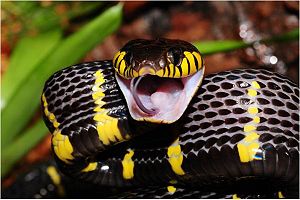Denmotoxin is a snake venom protein produced by Boiga dendrophila (mangrove catsnake) which belongs to a family of well studied three-fingered neurotoxins.
Denmotoxin belongs to a family of non-conventional three-finger toxins
Three-finger toxins (3FTXs) are the most common family of snake venom proteins with a conserved structure. The core structure of 3FTXs is formed by joined together by cysteine bridges.
Structure
Denmotoxin is amonomeric protein consisting of 77 amino acid residues. Multiple sequence alignment of denmotoxin reveals that the venom belongs to the family of non-conventional 3FTXs. Denmotoxin has 7 additional amino acid residues in its N-terminal when compared to other elapid 3FTXs; the N-terminus is also blocked by a pyroglutamic acid residue. The biological function of the pyroglutamic acid residue is currently unknown. There are 10 structurally important cysteine-residues in denmotoxin which form five stabilizing .Four of these disulphide bonds are located at the central core ( ) and the fifth at the tip of the first loop. The cysteine residues of all 3FTXs are highly conserved, whereas the other residues within the sequence express high variability. Denmotoxins consists of protruding from the globular core; this structure is typical for 3FTXs. There are two highly on the protein: one at the tip of the central loop and one at the 3 first residues of the N-terminus; the expected active site of denmotoxin is at the tip of the central loop. The secondary structure of denmotoxin includes a triple stranded anti-parallel β-sheet (“3 fingers”) ; two of the β-strands in this structure connect to the second loop central loop and one β-strand connects to the third loop.
Denmotoxin is a non-covalent monomeric protein possessing 77 amino acid residues including 10 structurally important cysteines. Multiple sequence alignment of denmotoxin reveals that the venom belongs to the family of non-conventional 3FTXs. Denmotoxin consists of 3 polypeptide loops; importantly the cysteines of the toxin form which stabilize the structure. Four of these disulphide bonds are located at the central core and fifth at the tip of the first loop. Denmotoxin has 7 additional amino acid residues in its N-terminal when compared to other elapid 3FTXs; the N-terminus is also blocked by a pyroglutamic acid residue. The cysteine residues of all 3FTXs are highly conserved, whereas the other residues within the sequence express high variabilty. The biological function of the pyroglutamic acid residue is currently unknown. There are two highly flexible regions on the protein: one at the tip of the central loop and one at the 3 first residues of the N-terminus.
Denmotoxin interacts with acetylcholine-receptors
Biochemistry of denmotoxin is unique for its specifity to bird nicotinic acetyl choline receptors (nAChR). Binding of denmotoxin to a chick muscle AChR (a1ByS) is a highly irreversible when interaction with identical subunit assembly in mouse AChR was reversible. Here a picture of the complex where the toxin is bound to the AChR. The active sites which interact with the receptor.
Active site organisation
Conclusions
Snake venom can kill!

